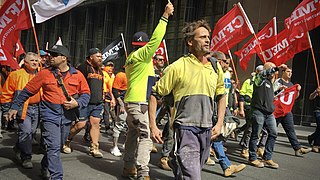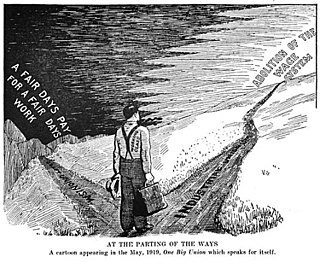Related Research Articles

In the arts and in literature, the term avant-garde identifies a genre of art, an experimental work of art, and the experimental artist who created the work of art, which usually is aesthetically innovative, whilst initially being ideologically unacceptable to the artistic establishment of the time. The military metaphor of an advance guard identifies the artists and writers whose innovations in style, form, and subject-matter challenge the artistic and aesthetic validity of the established forms of art and the literary traditions of their time; thus how the artists who created the anti-novel and Surrealism were ahead of their times.
Industrial music is a genre of music that draws on harsh, mechanical, transgressive or provocative sounds and themes. AllMusic defines industrial music as the "most abrasive and aggressive fusion of rock and electronic music" that was "initially a blend of avant-garde electronics experiments and punk provocation". The term was coined in the mid-1970s with the founding of Industrial Records by members of Throbbing Gristle and Monte Cazazza. While the genre name originated with Throbbing Gristle's emergence in the United Kingdom, artists and labels vital to the genre also emerged in the United States and other countries.

Strike action, also called labor strike, labour strike, or simply strike, is a work stoppage caused by the mass refusal of employees to work. A strike usually takes place in response to employee grievances. Strikes became common during the Industrial Revolution, when mass labor became important in factories and mines. As striking became a more common practice, governments were often pushed to act. When government intervention occurred, it was rarely neutral or amicable. Early strikes were often deemed unlawful conspiracies or anti-competitive cartel action and many were subject to massive legal repression by state police, federal military power, and federal courts. Many Western nations legalized striking under certain conditions in the late 19th and early 20th centuries.

Postmodern art is a body of art movements that sought to contradict some aspects of modernism or some aspects that emerged or developed in its aftermath. In general, movements such as intermedia, installation art, conceptual art and multimedia, particularly involving video are described as postmodern.
Avant-garde music is music that is considered to be at the forefront of innovation in its field, with the term "avant-garde" implying a critique of existing aesthetic conventions, rejection of the status quo in favor of unique or original elements, and the idea of deliberately challenging or alienating audiences. Avant-garde music may be distinguished from experimental music by the way it adopts an extreme position within a certain tradition, whereas experimental music lies outside tradition.

Genesis Breyer P-Orridge was an English singer-songwriter, musician, poet, performance artist, visual artist, and occultist who rose to notoriety as the founder of the COUM Transmissions artistic collective and lead vocalist of seminal industrial band Throbbing Gristle. P-Orridge was also a founding member of Thee Temple ov Psychick Youth occult group, and fronted the experimental pop rock band Psychic TV.

Varvara Fyodorovna Stepanova was a Russian artist. With her husband Alexander Rodchenko, she was associated with the Constructivist branch of the Russian avant-garde, which rejected aesthetic values in favour of revolutionary ones. Her activities extended into propaganda, poetry, stage scenery and textile designs.

A strikebreaker is a person who works despite a strike. Strikebreakers are usually individuals who were not employed by the company before the trade union dispute but hired after or during the strike to keep the organization running. Strikebreakers may also refer to workers who cross picket lines to work.

Anti-art is a loosely used term applied to an array of concepts and attitudes that reject prior definitions of art and question art in general. Somewhat paradoxically, anti-art tends to conduct this questioning and rejection from the vantage point of art. The term is associated with the Dada movement and is generally accepted as attributable to Marcel Duchamp pre-World War I around 1914, when he began to use found objects as art. It was used to describe revolutionary forms of art. The term was used later by the Conceptual artists of the 1960s to describe the work of those who claimed to have retired altogether from the practice of art, from the production of works which could be sold.

Cubo-Futurism was an art movement, developed within Russian Futurism, that arose in early 20th century Russian Empire, defined by its amalgamation of the artistic elements found in Italian Futurism and French Analytical Cubism. Cubo-Futurism was the main school of painting and sculpture practiced by the Russian Futurists. In 1913, the term ‘Cubo-Futurism’ first came to describe works from members of the poetry group ‘Hylaeans’, as they moved away from poetic Symbolism towards Futurism and zaum, the experimental “visual and sound poetry of Kruchenykh and Khlebninkov”. Later in the same year the concept and style of ‘Cubo-Futurism’ became synonymous with the works of artists within Ukrainian and Russian post-revolutionary avant-garde circles as they interrogated non-representational art through the fragmentation and displacement of traditional forms, lines, viewpoints, colours, and textures within their pieces. The impact of Cubo-Futurism was then felt within performance art societies, with Cubo-Futurist painters and poets collaborating on theatre, cinema, and ballet pieces that aimed to break theatre conventions through the use of nonsensical zaum poetry, emphasis on improvisation, and the encouragement of audience participation.

Lajos Kassák was a Hungarian poet, novelist, painter, essayist, editor, theoretician of the avant-garde, and occasional translator. He was among the first genuine working-class writers in Hungarian literature.

The Association of Artists of Revolutionary Russia, later known as Association of Artists of the Revolution was a group of artists in the Soviet Union in 1922–1933. Diverse members of the group gained favor as the legitimate bearers of the Communist ideas into the world of art, formulating framework for the socialist realism style.

The Industrial Workers of the World (IWW) is a union of wage workers which was formed in Chicago in 1905 by militant unionists and their supporters due to anger over the conservatism, philosophy, and craft-based structure of the American Federation of Labor (AFL). Throughout the early part of the 20th century, the philosophy and tactics of the IWW were frequently in direct conflict with those of the AFL concerning the best ways to organize workers, and how to best improve the society in which they toiled. The AFL had one guiding principle—"pure and simple trade unionism", often summarized with the slogan "a fair day's pay for a fair day's work." The IWW embraced two guiding principles, fighting like the AFL for better wages, hours, and conditions, but also promoting an eventual, permanent solution to the problems of strikes, injunctions, bull pens, and union scabbing.
In the visual arts, late modernism encompasses the overall production of most recent art made between the aftermath of World War II and the early years of the 21st century. The terminology often points to similarities between late modernism and post-modernism although there are differences. The predominant term for art produced since the 1950s is contemporary art. Not all art labelled as contemporary art is modernist or post-modern, and the broader term encompasses both artists who continue to work in modern and late modernist traditions, as well as artists who reject modernism for post-modernism or other reasons. Arthur Danto argues explicitly in After the End of Art that contemporaneity was the broader term, and that postmodern objects represent a subsector of the contemporary movement which replaced modernity and modernism, while other notable critics: Hilton Kramer, Robert C. Morgan, Kirk Varnedoe, Jean-François Lyotard and others have argued that postmodern objects are at best relative to modernist works.

Emit Snake-Beings also known as Snakebeings is a British/New Zealand writer multi-media visual artist and sound artist who has also worked in kinetic art, DIY ethos, DIY technology, sculpture, Cinematography, and Video Editing. He has a master's degree from the University of Waikato, and in 2016 was awarded a PhD, entitled The DiY ['Do it yourself'] Ethos: A participatory culture of material engagement for his work linking the DIY ethic and Maker culture with contemporary theory of material agency and Material culture. Recent publications have focused on developing an idea of techno-animism and ethnographic studies of technology.
Avant-garde art and American pop culture have had an intriguing relationship from the time of the art form's inception in America to the current day. The art form, which began in the early half of the nineteenth century in Europe, started to rise slowly in America under the guise of Dadaism in 1915. While originally formed under a group of artists in New York City who wanted to counter pop culture with their art, music, and literature the art form began to grow into prominence with American pop culture due to a variety of factors between the 1940s to the 1970s. However, from many factors that arose in the late 1970s, avant-garde began to both lessen in prominence and began to blend with the pop culture to the point in which most art critics considered the art form extinct.

Ukrainian avant-garde is the avant-garde movement in Ukrainian art from the end of 1890s to the middle of the 1930s along with associated artists in sculpture, painting, literature, cinema, theater, stage design, graphics, music, architecture. Some well-known Ukrainian avant-garde artists include: Kazimir Malevich, Alexander Archipenko, Vladimir Tatlin, Sonia Delaunay, Vasyl Yermylov, Alexander Bogomazov, Aleksandra Ekster, David Burliuk, Vadym Meller, and Anatol Petrytsky. All were closely connected to the Ukrainian cities of Kyiv, Kharkiv, Lviv, and Odesa by either birth, education, language, national traditions or identity. Since it originated when Ukaine was part of the Russian Empire, Ukrainian avant-garde has been commonly lumped by critics into the Russian avant-garde movement.

A monstration is a public performance similar to a demonstration but intended as creative performance art, often parodying a serious demonstration. The term was coined by Russian artist Ivan Dyrkin in 2004, and the phenomenon has been most popular in Russia.
The first known reference to an Art Strike appears in an Alain Jouffroy essay: "What's To Be Done About Art?".

Redas Diržys is the director of the Art School of Alytus, in Alytus, Lithuania. Apart from this role, he is also known internationally for social art interventions, performance art and socially engaged artistic practices.
References
- ↑ Diržys, Redas. "WE ARE THE LABOUR UNION OF DATA MINERS AND PSYCHIC WORKERS". www.4.alytusbiennial.com.
- ↑ http://www.patogupirkti.lt/Redas-Dirzys-Kestutis-Sapoka-knygos/%7C "Alytus avant-gardeism: from street art to psychic workers strike by Redas Diržys and Kestutis Šapoka"
- ↑ "Tribute to Comrade Gustav Metzger – IWW 000 Dead and Destructive Reproductive Psychic Workers Union – (hyper/meta/psychogeo/situo)graphy". www.psychogeography.org.
- ↑ "Asger Jorn and Critique of Eurocentrism - Echo Gone Wrong". 27 August 2015.
- ↑ Snake-Beings, Emit (May 2013). "The Construction of Karen Karnak: The Multi-Author Function". Media International Australia incorporating Culture and Policy. 147: 104. Retrieved 15 December 2021.